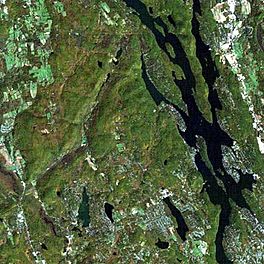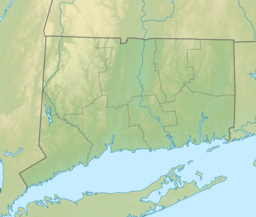Candlewood Lake facts for kids
Quick facts for kids Candlewood Lake |
|
|---|---|

Candlewood Lake from space (NASA photo)
|
|
| Location | Fairfield / Litchfield counties, Connecticut, US |
| Coordinates | 41°29′N 73°27′W / 41.49°N 73.45°W |
| Lake type | Reservoir |
| Primary inflows | Rocky River, Housatonic River |
| Primary outflows | Rocky River, Housatonic River |
| Basin countries | United States |
| Max. length | 11 miles (18 km) |
| Max. width | 2 miles (3.2 km) widest point |
| Surface area | 5,420 acres (21.9 km2) |
| Average depth | 40 feet (12 m) |
| Max. depth | 90 feet (27 m) |
| Water volume | 167,112 acre-feet (206,130,000 m3) |
| Shore length1 | 60 mi (97 km) |
| Surface elevation | 429 feet (131 m) |
| Islands | 12 |
| Settlements | Brookfield, Danbury, New Fairfield, New Milford, and Sherman |
| 1 Shore length is not a well-defined measure. | |
Candlewood Lake is a huge man-made lake located in western Connecticut, in the northeastern United States. It's the biggest lake in Connecticut, covering about 8.4 square miles! This large lake touches five towns: Brookfield, Danbury, New Fairfield, New Milford, and Sherman. Some of the most expensive homes in Connecticut are found along its shores.
Contents
How Candlewood Lake Was Made
The Big Idea: Making Electricity
Back in 1926, a company called Connecticut Light and Power Company (CL&P) had a cool idea. They wanted to build the first big "pumped storage" power plant in the US. Imagine a giant battery, but instead of storing electricity, it stores water!
The plan was to create a huge lake and fill it with water from the nearby Housatonic River. Then, when people needed a lot of electricity, they would let the water flow down a big pipe (called a penstock) and spin a turbine. This turbine would then make electricity. When there was extra electricity, they could use it to pump water back up into the lake, ready for later. This way, they could make power when it was most needed.
Building the Lake
Once the decision was made, things moved fast. About 50 surveyors started mapping the valley. Lawyers helped buy land from families, some of whom had owned their farms since before the American Revolution. CL&P had the power to buy the land, even if people didn't want to sell. Many buildings were left standing, and some farm tools were left behind before the valley was flooded. A small cemetery was also moved to a new spot.
Starting in July 1926, nearly 1,400 workers began building the lake. About 500 men cut down 4,500 acres of trees by hand, burning the wood in huge bonfires. They built several dams. The biggest dam, at the north end of the valley, was 952 feet wide and 100 feet high when it was finished.
On February 25, 1928, they started pumping water into the valley from the Housatonic River. The Rocky River and its smaller streams were supposed to fill about one-fourth of the lake. The rest of the water was pumped in. The valley filled up quickly! By September 29, 1928, the water reached its planned level, and Candlewood Lake was officially finished.
CL&P owned and ran the lake and its power plant for many years. In 2006, a company called FirstLight Power Resources bought the lake and the power plant.
Fun Things to Do at Candlewood Lake
Candlewood Lake is a very popular place for visitors, especially in the summer. Many people from New York City have second homes here. You can enjoy the lake all year round, but summer is the busiest time for:
- Swimming
- Fishing
- Boating
- Golfing
The lake has about 60 miles of shoreline. You'll find resorts, golf courses, beaches, and places to dock boats (marinas) all around it.
Boating Rules
To keep everyone safe, there are rules for boats:
- During the day, boats can go up to 45 miles per hour.
- At night (from 30 minutes after sunset to 30 minutes before sunrise), the speed limit is 25 miles per hour.
- You must go 6 miles per hour or less if you are within 100 feet of the shore, a dock, or other boats.
Exploring Under the Water
The lake is about 40 feet deep in most places, but some spots go down to 80 feet! If you're a scuba diver, you can explore what's left of the old buildings and roads from before the lake was created. Divers have found cool things like old Model T cars, parts of small planes that crashed, and even old covered bridges underwater.
Chicken Rock
Candlewood Lake is also famous for "Chicken Rock." This is a big rock that sticks out into the lake, and people love to jump off it into the water. There's also a rope swing nearby where you can swing out over the water. The rock is about 25 feet high.
Many private beaches are located around Candlewood Lake, including Lynn Deming Park and Candlewood Lake Club.
Lake Challenges: Weeds and Mussels
Candlewood Lake sometimes has problems with too much plant growth, like "eelgrass" and "Eurasian milfoil," especially in shallower areas. These plants can make the water cloudy. Because of the plants and dirt stirred up by boats, you can usually only see about 5 to 20 feet into the water.
To help control the weeds, the lake's water level is usually lowered by about 10 feet during the winter. This tries to freeze the weeds. People have also tried cutting the weeds with special machines, but that hasn't worked perfectly. Scientists have also tried using chemicals and even animals to fight the weeds. For example, in 2015, grass-eating carp (a type of fish) were put into the lake to eat the plants.
In 2016, a harmful invasive species called "zebra mussels" was found near the lake's power station. People are worried these mussels might get into the lake itself, as they can cause problems for the environment and boats.
Candlewood Lake's History
Before the lake was filled, there was a small village called Jerusalem that was completely covered by the rising waters.
Even before the lake was finished, people realized it would be a great place for summer vacations. Land prices along the future shoreline quickly went up, and summer homes started appearing almost right away.
The lake was almost named Lake Danbury. But it ended up being named Candlewood Lake after Candlewood Mountain in New Milford. The mountain itself was named after the "Candlewood tree," whose young branches early settlers sometimes used as candles.
Islands in the Lake
Candlewood Lake has several islands. Here are some of them:
- Green Island
- Deer Island
- Cedar Island
- Oak Island
- Rock Island
- Sand Island
- Shipwreck Island
- Skeleton Island
- Thistle Island
- Banger Islands





